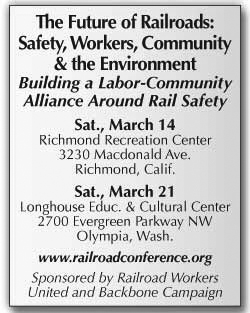

Vol. 79/No. 6 February 23, 2015
The morning after the disaster New York Gov. Andrew Cuomo told a CBS news show, “Sometimes there are just accidents.”
Pressed on why steps aren’t being taken to eliminate ground-level crossings and replace them with under- or overpasses, Cuomo told Time Warner channel NY1, “In theory it’s a nice idea. In practicality, do we have the money, do we have the time? And is it one of the top priority safety projects? I would say no.”
Since 2003 there have been 260 grade-crossing “accidents” on the three commuter rail systems that serve the greater New York City area — Metro-North, New Jersey Transit and the Long Island Rail Road. According to the Federal Railroad Administration, 73 people were killed and 148 injured.
After a crossing gate came down on the SUV, Brody apparently pulled forward into the path of the crowded train, according to Robert Sumwalt of the National Transportation Safety Board. The train’s engineer, Steven Smalls, slammed on the brakes, but it was too late.
Smalls narrowly escaped being impaled when the third rail pierced the train. He helped evacuate passengers from the burning train and was later hospitalized for smoke inhalation.
Metro-North only assigned two crew members to the train — Smalls and one conductor — who helped get passengers off all eight cars.
The crash took place during the evening rush hour at an intersection near a highway entrance. Red lights and crossing gates had been installed there after a deadly crash in 1984 in which a train struck a vehicle. State transportation officials planned five years ago to install an additional set of lights to give drivers more warning of approaching trains, but never did.
Regular commuters have told the press they consider the crossing dangerous. Lance Sexton, an electronic equipment assembler who lives in Valhalla, told the New York Times, “We know that coming down the hill … you have to put the brakes on earlier.” He said he worries about how soon the trains pass after the gates come down. Of the driver who found herself on the tracks, Sexton said, “It happens.”
At her funeral Feb. 6, Alan Brody said his wife had been driving in an unfamiliar area. He said he had once been there and “remember thinking, ‘Are you kidding?’ Who could imagine that a major commuter railroad runs through this?”
Ending grade crossings not a priority
Nationwide, only 15 percent of the more than 250,000 locations where railroad tracks and roadways intersect have a bridge or underpass to separate the tracks from cars and pedestrians. There are about 270 deaths a year at public and private grade crossings in the United States. On average, someone is hit by a train every three hours.
This is not just a U.S. problem. Roughly one person a day is killed by trains at grade crossings in Europe. Some 15,000 people are killed each year trying to cross railroad tracks in India, especially in crowded working-class areas in the country’s major cities. In Mumbai alone 6,000 people are killed each year.
“No civilized society can accept such a massacre on their railway system,” said a 2012 report by the High Level Safety Review Committee, which was set up by the Indian government after outcry against the massive number of deaths on the tracks. The report laid the blame squarely on the railway bosses.
Every single one of these killings is preventable by installing under- or overpasses.
Worsening working conditions on the job and growing danger to communities along train routes are sparking workers to fight back on U.S. railroads. Last September, trainmen and engineers on the BNSF Railway overwhelmingly rejected a proposal from the bosses to cut train crews to one person.
There have been several serious incidents on Metro-North in the last couple years, including a December 2013 derailment in the Bronx that killed four passengers and injured 70. A report by the Federal Railroad Administration on that so-called accident said Metro-North management had a “deficient safety culture.”

|